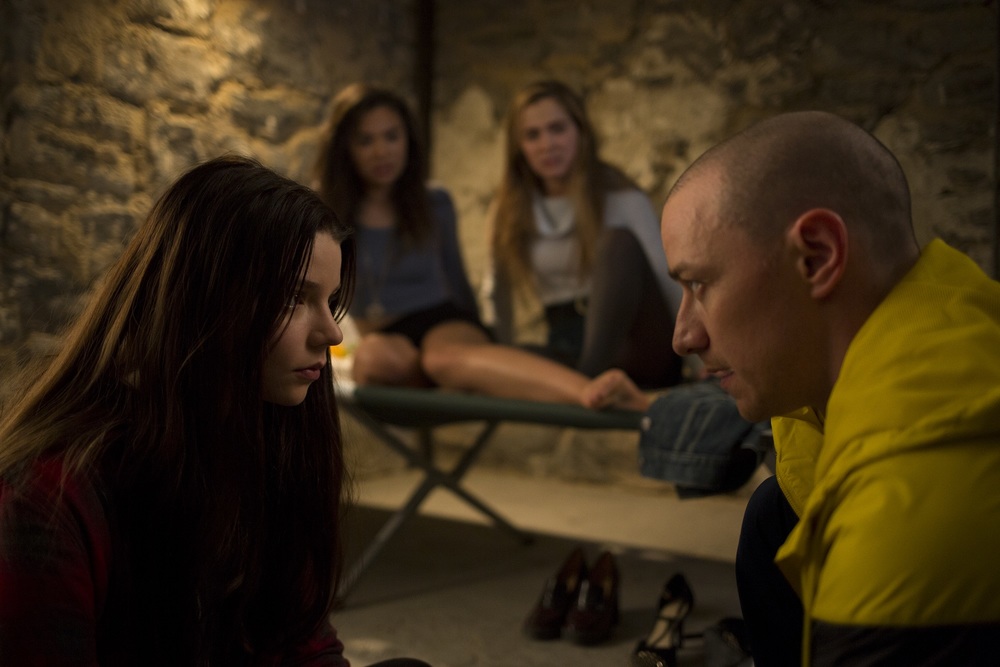After a string of critical and audience failures like “After Earth” and “The Happening,” M. Night Shyamalan seemed destined to remain merely a punch line for his signature twist endings and declining quality. But with 2015’s “The Visit” and his latest film “Split,” the director is finally returning to his status as a capable thriller helmer who knows how to keep the audience engaged and pleasantly unsettled.
“Split” wastes no time in setting up its high-concept premise. In its first minutes, two teenage friends (Haley Lu Richardson and Jessica Sula) and high-school outcast Casey (Anya Taylor-Joy) are abducted in a parking lot by Kevin (James McAvoy). Through his therapy sessions with Dr. Fletcher (Betty Buckley), we learn that he suffers from Dissociated Identity Disorder, meaning that Kevin’s body also contains 23 other personalities who can manifest different physical traits. Among others, there’s sweet fashion designer Barry, silly 9-year-old boy Hedwig, quietly menacing Dennis, and proper British lady Patricia. As the young women try to escape their basement prison, they interact with Kevin’s various personalities, but a mysterious final identity may prove the most dangerous of all.
Though McAvoy doesn’t get the chance to show us all 24 personalities within Kevin’s body, he does get to display about a third of them, each a distinct character with his or her own voice, movements and carriage. In the film’s last act, he gets to run through a number in a breathless sequence. If “Split” were a drama released in the final months of the year, he’d be getting awards talk, but its “lesser” genre status means that he likely won’t receive the attention the performance(s) deserve.
McAvoy will earn much of the praise for the film’s acting, but audiences shouldn’t overlook Taylor-Joy. Between “Split” and last year’s “The Witch” and “Morgan,” the actress has spent a lot of time alternately sharing in and invoking the audience’s fear since she burst onto the screen. She’s wonderful here, showing a restrained terror and determination that other actresses would either over- or underemphasize. There are layers of performance in what she’s doing, playing Casey as a woman who understands that acting a certain way for the various facets of her captor will have varying results. Flashbacks reveal an enduring pain that gives her more insight into her current struggle than her fellow captives have, and that trauma shows on Taylor-Joy’s expressive face throughout the film.  “Split” may be marketed more as a horror movie than a psychological thriller, but there are blessedly few jump scenes that turn the audience into giggling nervous wrecks. Instead, there’s a constant feeling of dread that begins just a few minutes into the film and doesn’t let up, except for brief moments of levity from the young Hedwig character. But it isn’t just McAvoy and Taylor-Joy’s fine work that creates that feeling of unease; cinematographer Michael Gioulakis proves he’s just as good with revealing the terror in confined spaces as he was with wide expanses in “It Follows.” There’s particularly nice use of light and darkness as well.
“Split” may be marketed more as a horror movie than a psychological thriller, but there are blessedly few jump scenes that turn the audience into giggling nervous wrecks. Instead, there’s a constant feeling of dread that begins just a few minutes into the film and doesn’t let up, except for brief moments of levity from the young Hedwig character. But it isn’t just McAvoy and Taylor-Joy’s fine work that creates that feeling of unease; cinematographer Michael Gioulakis proves he’s just as good with revealing the terror in confined spaces as he was with wide expanses in “It Follows.” There’s particularly nice use of light and darkness as well.
Shyamalan shouldn’t be discounted either. Despite a long detour that made viewers wonder if he’d ever find his way again, he’s back in fine form. Rather than reinventing himself, he’s returned to what we loved about “The Sixth Sense” and “Unbreakable,” without feeling like a retread of either film or repeating the worst mistakes of his misfires. However, he still indulges some of his quirks – such as casting himself in a small role – that stop the movie in its tracks. As always, he’s also making a larger statement here, which I won’t spoil. I’ve gone back and forth on the inclusion of this serious theme in a largely frivolous film (particularly from a male writer-director), but it ultimately felt surprisingly resonant to me for a movie that could otherwise have been simply thrilling fun. He still knows how to manipulate an audience with an original story, and with “Split,” we don’t mind him pulling the strings again. [B]





